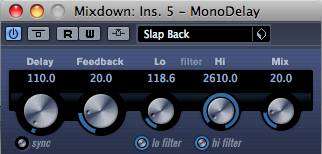I recently watched a video featuring Eddie Kramer, the sound engineer of acts such as Jimi Hendrix, Led Zeppelin and occasionally the Beatles. In this video, he explains how he has worked with Waves to create a series of “plug’n play” software plugins, each dedicated to the processing of either guitar, drums, bass or vocals. The guitar plugin features compression, slapback echo, flange and reverb. And he goes on saying that the slapback echo brings a bit of an “analog” feel but that it is not an effect that is very popular anymore.
So this got me thinking. The slapback echo, also known as slap echo, was very common in the 50s and 60s. It was created by recording with a tape recorder and playing back the same tape a fraction of a second later using another “head”, generating a single repeat type of short echo. Its use is very obvious on early rock’n roll and rockabilly records, particularly on vocals. It can also be heard on the guitar on a number of Hendrix tunes like “Voodoo Chile Slight Return” where a slapback echo augmented by an old plate reverb creates a really cool dripping kind of tone. It is easy to reproduce with today’s analog or digital delay pedals as well as software plugins.
I experimented with my recording software (Cubase 5) and put together this video that shows the same tone without and then with a slapback echo. I think it is pretty cool, I might use it more in the future! See after the video for some slapback settings for the Cubase delay plugin and the good old BOSS DD-3 delay pedal.
For the basic tone I used my 1978 Telecaster with a Fender Champ tube amp and then kicked in a Pro Co RAT 2 distortion pedal (settings on the RAT 2: DISTORTION at 2 o’clock, FILTER at 3 o’clock and VOLUME at 2 o’clock).
In Cubase I used the following delay settings:
With a BOSS DD-3 digital delay pedal, the following settings will give you a nice fattening slapback echo: Mode 200ms, E.LEVEL at 12 o’clock, F.BACK at 9 o’clock and D.TIME at 4 o’clock. You might want to vary the E.LEVEL or D.TIME to taste.
It would be easy to reproduce this effect with any other model of delay, just set the “delay time” between 70 and 200ms and the “feedback” quite low to have just one repeat.

